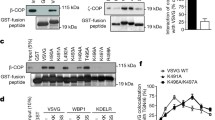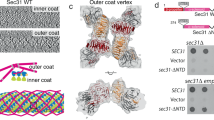Abstract.
Vesicular transport is the basic communication mechanism between different compartments in a cell and with the environment. In this review I discuss the principles of vesicle generation and consumption with particular emphasis on the different types of coat proteins and the timing of the shedding of the coat proteins from transport containers. In recent years it has become clear that there are more coat complexes than the classical COPI, COPII and clathrin coats. These additional coats may generate vesicles that transport cargo in a temporally and/or spatially controlled manner. Work over the last years suggests that GTP hydrolysis occurs early during vesicle biogenesis, destabilizing the coat perhaps before fission of the vesicle from the donor membrane occurs. Recent findings imply, however, that tethers at the receiving compartment specifically detect the coat on vesicle. (Part of a Multi-author Review)
Similar content being viewed by others
Author information
Authors and Affiliations
Corresponding author
Rights and permissions
About this article
Cite this article
Spang, A. Membrane traffic in the secretory pathway. Cell. Mol. Life Sci. 65, 2781–2789 (2008). https://doi.org/10.1007/s00018-008-8349-y
Published:
Issue Date:
DOI: https://doi.org/10.1007/s00018-008-8349-y




